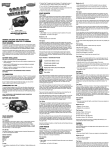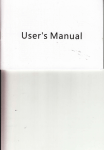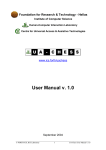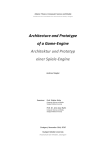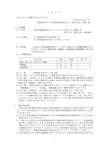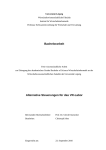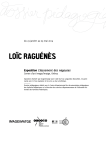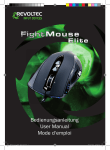Download Pdf format
Transcript
Foundation for Research & Technology - Hellas Institute of Computer Science Human-Computer Interaction Laboratory Centre for Universal Access & Assistive Technologies Access Invaders http://www.ics.forth.gr/hci/ua-games/access-invaders/ User Manual v. 1.0 January 2006 © ICS-FORTH, HCI Laboratory 1 Access Invaders User Manual v.1.0 Table of Contents 1. 2. 3. Introduction...........................................................................................................3 Technical Requirements.......................................................................................4 Installation ............................................................................................................4 3.1. Microsoft Windows .......................................................................................4 3.2. GNU/Linux ....................................................................................................4 4. Introduction to the Game......................................................................................5 5. Playing the Game.................................................................................................6 5.1. Selecting a profile.........................................................................................6 5.2. Main Menu....................................................................................................7 5.3. Controlling the Spaceship ............................................................................8 5.4. In-game Menu ..............................................................................................9 5.5. Text entry .....................................................................................................9 6. Default Game Profiles: Characteristics & Controls.............................................11 6.1. Basic...........................................................................................................11 6.1.1. 6.2. Single switch ..............................................................................................13 6.2.1. 6.3. Controls ......................................................................................................... 16 Demo ..........................................................................................................17 6.6.1. 6.7. Controls ......................................................................................................... 15 Classic........................................................................................................16 6.5.1. 6.6. Controls ......................................................................................................... 14 Non-visual ..................................................................................................15 6.4.1. 6.5. Controls ......................................................................................................... 13 X-Large.......................................................................................................14 6.3.1. 6.4. Controls ......................................................................................................... 12 Controls ......................................................................................................... 17 Chess Invaders ..........................................................................................18 6.7.1. Controls ......................................................................................................... 18 7. 8. 9. Implementation information ................................................................................20 Frequently Asked Questions (FAQ) ...................................................................21 Background ........................................................................................................22 9.1. Universally Accessible Games (UA-Games) ..............................................22 9.2. Space Invaders ..........................................................................................22 10. Contact info ........................................................................................................24 Annex A: Configuring the Game ................................................................................25 A.1. Input configuration ..........................................................................................25 A.1.1. Keys/Buttons ........................................................................................................ 25 A.1.1.1. Keys/Buttons values reference ................................................................................... 26 A.1.2. Axes...................................................................................................................... 28 A.1.2.1 Axes values reference..................................................................................................28 A.2. Output configuration .......................................................................................28 A.3. Gameplay configuration ..................................................................................29 © ICS-FORTH, HCI Laboratory 2 Access Invaders User Manual v.1.0 1. Introduction Access Invaders is an accessible remake of the classic Space Invaders game, developed by the Human-Computer Interaction Laboratory of ICS-FORTH in close cooperation with the Centre for Universal Access & Assistive Technologies, in the context of the Universally Accessible Games (UA-Games) Activity1. Access Invaders is designed to be Universally Accessible, i.e., it can be concurrently played by people with different abilities and preferences, including people with disabilities (e.g., low-vision, blind and hand-motor impaired). Access Invaders follows the principles of UA-Games and achieves Universal Access by supporting alternative input / output modalities and interaction techniques that can co-exist and cooperate in the game’s user interface, combined with tailorable player profiles and game content. The game is highly customizable and supports the creation and use of unlimited user profiles. Each game parameter can be adapted both based on the player's profile and the current game level. Every aspect of the game’s functionality is fully accessible through the mouse, the keyboard, any type of switches, and the joystick. For each device, several alternative interaction techniques (the parameters of which can be customized) are supported. Non-visual (audio-based) gameplay is also supported. In this case, full acoustic rendering of game information is provided through the use of spatial audio and of a built-in screen reader. In fact, the interaction capabilities of Access Invaders allow it to provide access even to people with combinations of disabilities, as for example blind hand-motor impaired persons. Multi-player games are also available, where people with different (dis)abilities can play cooperatively, sharing the same computer. In this case the game’s interaction parameters can be independently adjusted for each distinct player. An unlimited number of concurrent players is supported. Access Invaders can be found on-line at: www.ics.forth.gr/hci/ua-games/access-invaders 1 http://www.ics.forth.gr/hci/ua-games © ICS-FORTH, HCI Laboratory 3 Access Invaders User Manual v.1.0 2. Technical Requirements Access Invaders is designed to be cross-platform. The game can be played on any computer that runs Windows, or GNU/Linux. More specifically the game's requirements include: • Pentium class processor, or higher. • Display adapter capable of supporting a screen resolution of at least 1024x768. The adapter doesn't need to have 3D acceleration capabilities. • Sound card. • Microsoft Windows® XP or later, or any recent distribution of GNU/Linux®. • Screen resolution of at least 1024x768 when running the game in full screen more, or greater for playing in window mode. 3. Installation 3.1. Microsoft Windows To install the game in Microsoft Windows XP (or later), launch the setup program (access-invaders-1.0.exe) and follow its instructions. Note that the game does not require administrator privileges neither to install, nor to run2. After the game is installed, it will create a new entry entitled “Access Invaders” in the windows Start menu and, optionally, a desktop icon. To run the game, either select it from the Windows Start menu, or double click on the desktop icon (if it was created). 3.2. GNU/Linux To install the game in GNU/Linux, uncompress the game's archive (access-invaders1.0.tar.gz). You can do this from the command-line by typing “tar zxvf accessinvaders-1.0.tar.gz”. To run the game, just invoke the executable (invaders) that is located in the newly created directory (access-invaders-1.0). Note for expert Linux users: the distribution package is self-contained, so that you do not need to install any additional libraries in order to play the game. If, however, you already have any of the required libraries installed, these can be safely removed from the Lib sub-directory, as the game itself uses unmodified versions of these libraries. 2 As long as the user has write permissions to the installation folder. © ICS-FORTH, HCI Laboratory 4 Access Invaders User Manual v.1.0 4. Introduction to the Game As in the original Space Invaders game, your mission is to prevent a group of aliens to land on the ground where your spaceship is located by shooting them down. Your spaceship is equipped with a cannon with infinite ammunition. • The aliens traverse move from the left end of the screen to the right, and vice versa, while also moving closer and closer to the ground. Also, they constantly throw bombs against your spaceship. • A range of shields exists between the aliens and your spaceship, which you can use as cover. Unfortunately, they are gradually worn out by incoming shots coming from you, or the aliens. • Periodically an alien mothership appears to the top of the screen and travelling from left to right. If you manage to destroy it, you get additional bonus points. • When your spaceship gets destroyed, it is replaced by a brand new one. The number of spaceships (also referred to as “lives”) at your disposal is limited and it is indicated on the top of the screen, right next to your score. • The game ends when all of your spaceships have been destroyed. If your final score is high enough you get a place in the “Access Invaders Hall of Fame”. Of course, in Access Invaders, the presence, the characteristics and the behavior of each distinct game element can be totally controlled and altered depending on the particular players’ characteristics, requirements and preferences. A sample screenshot of the game illustrating the basic game elements is depicted in Figure 1. Figure 1: Sample game screenshot © ICS-FORTH, HCI Laboratory 5 Access Invaders User Manual v.1.0 5. Playing the Game 5.1. Selecting a profile When Access Invaders starts, the Profile Selection Menu (Figure 2) appears from which you can select a profile for the current game session. Profiles are sets of predefined (either by the game designer, or the user) preferences regarding both the interaction parameters (e.g., speech output, switch-based scanning, input device selection), and the game’s content and appearance (e.g., fonts, sprites, colors, backgrounds, sounds). Figure 2: Profile Selection Menu Access Invaders currently offers the following predefined profiles: 1. Basic: a remake of the original Space Invaders game. 2. Single switch: the whole game (menus & gameplay) can be controlled using a single mouse button, a keyboard key or any type of switch. 3. X-Large: enlarged sprites and fonts, suitable for people with low vision, or a very small screen. 4. Non-visual: the gameplay is adapted for non-visual gameplay, suitable for blind people, or anyone who would like to play without using, or looking at the screen. 5. Classic: the content and gameplay characteristics of the “Basic” profile are adapted to the look-and-feel of the original “Space Invaders” game. 6. Demo: a demonstration of the level of configurability that Access Invaders can offer. 7. 3 Chess Invaders: an inside joke on the UA-Chess3 game (also developed by the HCI Laboratory of ICS-FORTH), where the content of the “Basic” profile is adapted using sprites from the UA-Chess game. http://www.ics.forth.gr/hci/ua-games/uachess © ICS-FORTH, HCI Laboratory 6 Access Invaders User Manual v.1.0 More details about each profile are included in Section 6 “Default Game Profiles”. You can select a profile using anyone of the following methods (which can also be configured): • Mouse: (a) point and click using the left mouse button on the profile name, or (b) use the mouse wheel (if available) to iterate through the available menu options and activate the currently highlighted by pressing the left mouse button (in this case the mouse pointer should not be over a menu item). • Keyboard: use the “UP/DOWN”, or the “LEFT/RIGHT” arrow keys to browse the menu options and the “SPACE” or the “RETURN” key to select. In addition to the above, the profile names are scanned automatically, i.e., the focus shifts from a profile to the next one every 4 seconds. Then, you can activate the currently focused profile using any of the aforementioned methods. You can change the active profile at any time. To access the Profile Selection Menu just select the related option from the game’s Main Menu. 5.2. Main Menu After selecting a profile, a short introductory text, followed by the game credits, is presented. You can skip this by pressing any key (including mouse and joystick buttons). Then, the game’s Main Screen (Figure 3) appears. By pressing again any key, the game's Main Menu (Figure 4) fades in. This menu can be used similarly to the Profile Selection Menu (with some adaptations depending on the currently active player profile). Figure 3: Main Screen The Main Menu offers the following options: • New Game: starts a new game using the currently active profile. • Change Profile: go back to the Profile Selection Menu (see Section 5.1). © ICS-FORTH, HCI Laboratory 7 Access Invaders User Manual v.1.0 • Options: contains the following: − Toggle Full Screen: select if the game will be displayed in a window or in the whole screen. − Test Text Entry: demonstration of how a user can input text in the game (e.g., when a score qualifies for the Hall of Fame). • Hall of Fame: the scores of the top 10 players. Each distinct profile has its own Hall Of Fame. • Quit: exit Access Invaders. Figure 4: Main Menu 5.3. Controlling the Spaceship In general, the player’s spaceship can be controlled using any, or all of the following devices: • Keyboard • Mouse • Joysticks or joystick compatible game pads • Switches (emulating keystrokes) User controls differ depending on the active game profile and the player number (e.g., 1st player, 2nd player). User controls for each game profile are described in detail in Section 6 “Default Game Profiles”. © ICS-FORTH, HCI Laboratory 8 Access Invaders User Manual v.1.0 5.4. In-game Menu Figure 5: In-game Menu While playing, you can activate the In-game Menu (Figure 5) through which you can do the following: • Continue Game: return to the game and continue playing. • Abort Game: end the current game and return to the Main Menu. • Restart Game: restart the current game. • New Player: add another player to the current game (if this option is supported by the currently active profile). The In-game Menu can be activated by pressing the “Esc” key. Additionally, in each profile alternative ways for activating it can be defined (e.g., the “RETURN button is kept pressed for more than 4 seconds”). 5.5. Text entry Currently, the text entry screen (Figure 6) is only used for typing in your name if your score qualifies for the Hall of Fame. The screen contains a virtual keyboard which comprises several lines of letters, numbers and symbols. The last two symbols of the virtual keyboard are “BS”, which can be used for erasing the last character of the typed text and “OK”, which is used for ending the text entry session. You can type some text using multiple alternative methods (and any combination of them): • Using the LEFT/RIGHT, or the UP/DOWN arrow keys: you can move the focus to the previous / next line correspondingly. The currently focused line is © ICS-FORTH, HCI Laboratory 9 Access Invaders User Manual v.1.0 indicated by two horizontal lines framing it. If you press the “RETURN” key the line is selected and using again the arrow keys you can shift the focus through the characters of the selected line. You can type a character by pressing the “RETURN” key. • Using the keyboard, you can directly type in any character that is included in the virtual keyboard. You can erase a character by pressing “BACKSPACE” and you can end the text entry session by pressing “RETURN”. • Using the mouse, you can directly point and click any character of the virtual keyboard. • Using the mouse wheel, you can shift the focus among lines and characters, similarly to using the arrow keys. Use the left mouse button to select (in this case the mouse pointer should not be over any character). If automatic scanning is enabled in the current profile, the focus moves automatically among the lines and characters of the virtual keyboard. You can select the currently focused item by pressing “RETURN” or the left mouse button. Figure 6: Text entry screen Depending on the active profile, the text entry screen may additionally provide an audible user interface. In this case, each character is read aloud when it gets the focus. Additionally, when a character is typed in, the current text entry is read. The text entry screen can infer if the return key was pressed to activate the currently selected symbol, or to denote the end of the typing session through the following heuristic rule: (a) when the user uses the physical keyboard to input text, the return key is used to denote the end of the typing session; (b) when the virtual keyboard is used (e.g., through the arrow keys or the mouse wheel), the return key acts as a mechanism for the activation of the currently focused character. Thus, although both input methods use the keyboard as an input device, they can be freely mixed without a problem. If you want to try out how text entry works, without having to achieve a high score first, you can select “Test Text Entry” from the “Options” menu. © ICS-FORTH, HCI Laboratory 10 Access Invaders User Manual v.1.0 6. Default Game Profiles: Characteristics & Controls The interactive behaviour and the content of the game is highly customizable and can be configured through the use of alternative game profiles. This section, describes the characteristics of the profiles that are created by default can installing the game. For more information about editing these profiles, or creating new ones please refer to “Annex A: Configuring the Game”. Access Invaders includes the following profiles: 1. Basic 2. Single switch 3. X-Large 4. Non-visual 5. Classic 6. Demo 7. Chess Invaders In addition to the specific controls described in each distinct profile, the following shortcuts can also be used: General Shortcuts Toggle Full Screen / Window mode F11 Toggle Sound effects mute M 6.1. Basic A remake of the original Space Invaders game. Basic characteristics: • Contains two groups of aliens. • Support for four concurrent players (cooperative game). © ICS-FORTH, HCI Laboratory 11 Access Invaders User Manual v.1.0 • • • All players can destroy and can be destroyed by all groups of aliens. Only two bullets can be active at any given time. The game's pace is quite fast. 6.1.1. Controls Player 1 Move Left LEFT ARROW Move Right RIGHT ARROW Fire SPACE Player 2 Move Left q Move Right w Fire e Player 3 Move Left a Move Right s Fire d Player 4 Move Left z Move Right x Fire c Other Activate In-game Menu / Pause ESC © ICS-FORTH, HCI Laboratory 12 Access Invaders User Manual v.1.0 6.2. Single switch This profile allows a player to interact with the game using only one “switch” (e.g., keyboard key, mouse / joystick button). This is achieved on one hand, by letting the player control only the spaceship’s movement direction, while the spaceship moves and fires automatically at a predefined speed, and on the other hand, by using the automatic scanning technique for interacting with the user interface (e.g., the menus, text entry). Also, the in-game menu can be invoked by pressing the switch for a predefined amount of time. 6.2.1. Controls Player 1 Toggle Movement Direction RETURN Other Activate In-game Menu / Pause RETURN pressed for 5 seconds © ICS-FORTH, HCI Laboratory 13 Access Invaders User Manual v.1.0 6.3. X-Large This profile uses large sprites and fonts along with clear and simple visual elements. 6.3.1. Controls Player 1 Move Left MOUSE Move Right MOUSE Fire LEFT MOUSE BUTTON Other Activate In-game Menu / Pause RIGHT MOUSE BUTTON © ICS-FORTH, HCI Laboratory 14 Access Invaders User Manual v.1.0 6.4. Non-visual A version of the game adapted to suit non-visual gameplay. Its main characteristics are the following: • There is only one group of aliens with a single column of one or more aliens. • The aliens do not fire against the player – the player's “lives” counter is omitted. • The player can fire against the aliens, but only two bullets can be concurrently active. • The game is over only if an alien touches the ground. • The background is not drawn. • There are no protective shields. • Score changes and interaction with the user interface provides audio feedback. • The spaceship emits a spatial sound, so that its position can be inferred acoustically. • The group of aliens also emits a distinctive “sonar-like” sound. 6.4.1. Controls Player 1 Move Left LEFT ARROW Move Right RIGHT ARROW Fire SPACE Other Activate In-game Menu / Pause ESC Read Score © ICS-FORTH, HCI Laboratory right ALT 15 Access Invaders User Manual v.1.0 6.5. Classic This profile tries to imitate the atmosphere and game-play of the original Space Invaders game by: • Using retro fonts and sprites for the aliens, the shields, the spaceship and the mothership. • Being single player. • Having only one group of aliens. • Permitting only one bullet to be active at any given time. • Using retro sound effects. 6.5.1. Controls Player 1 Move Left LEFT ARROW Move Right RIGHT ARROW Fire SPACE Other Activate In-game Menu / Pause © ICS-FORTH, HCI Laboratory ESC 16 Access Invaders User Manual v.1.0 6.6. Demo This profile constitutes a showcase of the configuration capabilities of Access Invaders. Its main characteristics are the following: • There are three distinct groups of aliens • Four players can play concurrently (cooperative game) • Player1 (yellow) can destroy only the that aliens belong to one of the groups (the insect looking ones) and can be destroyed by any alien • Player2 (gray) can destroy any alien but can only be destroyed only by aliens belonging to one of the groups (the insect looking aliens) • Player2’s bullets do not collide with the shields (they pass through them) • Player2 can be controlled using a single switch 6.6.1. Controls Player 1 Move left LEFT ARROW Move Right RIGHT ARROW Fire SPACE Player 2 Toggle Movement Direction S Other Activate In-game Menu / Pause ESC © ICS-FORTH, HCI Laboratory 17 Access Invaders User Manual v.1.0 6.7. Chess Invaders A profile offering another variation to the original game’s look-and-feel. Its distinctive characteristics are that: • It can be played by concurrently four players • It uses sprites that come from a chess game • Only one bullet can be active at any given time 6.7.1. Controls Player 1 Move left LEFT ARROW Move Right RIGHT ARROW Fire SPACE Player 2 Move Left Q Move Right W Fire - (autofire) Player 3 Move Left A Move Right S Fire - (autofire) © ICS-FORTH, HCI Laboratory 18 Access Invaders User Manual v.1.0 Player 4 Move Left Z Move Right X Fire - (autofire) Other Activate In-game Menu / Pause ESC © ICS-FORTH, HCI Laboratory 19 Access Invaders User Manual v.1.0 7. Implementation information Access Invaders was developed in C++, using the following 3rd party tools: • SDL4: a low level, cross-platform, graphics and input library. Used for drawing the graphics on the screen and getting input from the interaction devices supported by the game. • OpenAL5: a cross-platform 3D sound library. Used for the reproduction of sound effects, synthesized speech and music. • Festival Lite (Flite)6: a cross-platform runtime speech synthesis engine. Used for synthesizing speech from the textual messages and objects that appear on the screen • Freetype7: a font engine for true-type font rendering. Used for rendering the textual messages and objects that appear on the screen • Ogg Vorbis8: an open, patent-free, professional audio encoding, decoding and streaming technology. Libvorbis is used for the decoding of ogg music files. 4 http://www.libsdl.org http://www.openal.org 6 http://www.speech.cs.cmu.edu/flite 7 http://www.freetype.org/index2.html 8 http://www.vorbis.com 5 © ICS-FORTH, HCI Laboratory 20 Access Invaders User Manual v.1.0 8. Frequently Asked Questions (FAQ) 1. Is there going to be a interactive application for configuring the game and creating / editing profiles? − Yes, we plan to create one in the near future. If you want to be informed about it please contact us. 2. Will the game also support mp3 in addition to ogg? − For the time being, no. 3. Is recording and playback supported for a game session? − Yes. However, the recording and playback support is experimental and thus was removed from the current release. It is planned that the next version of the game will definitely support recording. © ICS-FORTH, HCI Laboratory 21 Access Invaders User Manual v.1.0 9. Background 9.1. Universally Accessible Games (UA-Games) A major goal of the of the HCI Laboratory and of the Centre for Universal Access & Assistive Technologies of ICS-FORTH is the active support of the electronic inclusion (e-inclusion) of all citizens, including people with disabilities, to the Information Society, through the design of products and services that follow the principles of Universal Access and Design for All. As part of this goal, we pursue the development of Universally Accessible Games9(UA-Games), i.e., interactive computer games that: • follow the principles of Universal Access and Design for All; • are proactively designed to optimally fit and adapt to different individual gamer characteristics without the need of further adjustments or developments; • can be concurrently played among people with different (dis)abilities (ideally, also when sharing the same computer); • can be played on alternative technological platforms and contexts of use using a large variety of devices (including assistive technologies). The underlying vision is that through such games people will be able to have fun and compete on an equal basis, while interacting easily and effectively, irrespective of: • their individual requirements, skills and preferences; • the technology they use; • where they are. UA-Games strongly cater for the needs and actively support the right of all people for social interaction and play irrespective of their individual differences, thus providing a steppingstone towards a more inclusive (and fun!) Information Society. The Centre for Universal Access and Assistive Technologies actively cooperates with several groups and associations of disabled people, at national and international level. In this context, our research and development work involves disabled users at different stages that contribute either as expert consultants or as potential end-users. 9.2. Space Invaders Access Invaders is based on the Space Invaders arcade (Figure 7) game which was designed by Toshihiro Nishikado of TAITO corp. and was released in 1978 in Japan and later to the United States of America by Midway. The game was a huge success, especially in Japan where, allegedly, it caused a shortage of 100 Yen coins. The 9 http://www.ics.forth.gr/hci/ua-games © ICS-FORTH, HCI Laboratory 22 Access Invaders User Manual v.1.0 immense popularity of the game, however, was stigmatized by the large number of thefts done by teenagers whose sole motive was to find more money to support their Space Invaders “addiction”. Other interesting trivia about the game, apart from the absolutely vast number of remakes it had (and obviously has) to sustain, include the fact that one of the most important characteristics of space invaders, the increase in the speed of the aliens when one of them was killed, was a side-effect of the execution of the game on the original arcade machine, which was able to process the game data faster, as it had to compute the movement of less aliens10. Figure 7: Original Space Invaders game instructions (left) and screenshot (right) 10 http://en.wikipedia.org/wiki/Space_invaders © ICS-FORTH, HCI Laboratory 23 Access Invaders User Manual v.1.0 10. Contact info For technical comments, suggestions, or questions, please contact: [email protected] For any further information about Access Invaders, please contact: Anthony Savidis email: [email protected] Tel: +30-2810-391749 Fax: +30-2810-391740 Foundation for Research and Technology - Hellas (FORTH) Institute of Computer Science (ICS) Human-Computer Interaction Laboratory Centre for Universal Access and Assistive Technologies Heraklion, Crete GR - 70013 Greece © ICS-FORTH, HCI Laboratory 24 Access Invaders User Manual v.1.0 Annex A: Configuring the Game Currently, the game can only be configured by editing textual configuration files. The configuration files have a “.conf” suffix and they are contained in the “Data/Profiles” subdirectory of the game. The Profiles directory contains a default version of all the “.conf” files required by the game. It also contains subdirectories that represent alternative profiles. These alternative profile subdirectories contain “.conf” files the contents of which override the default ones. An alternative profile subdirectory may contain only part of the required “.conf” files; for the ones missing the default files are used. Thus, any changes made to a “.conf” file of the Profiles directory affect the game's characteristics globally (but can be overridden in a specific profile), while any changes made to a file in an alternative profile subdirectory, affect only the specific profile. Note: The enumeration and documentation of all the available configuration categories and their parameters, as well as the provision of a detailed account of how a new profile can be created from scratch, are beyond the scope of this version of the manual. Thus, in the following sections, only a subset of the supported configuration categories are explained and documented, in order on the one hand to allow players to be able to modify the most essential game parameters, and on the other hand to help developing a mental model of how “.conf” files are organised and used. So, do not hesitate to experiment with the “.conf” files and try to totally redefine the game’s look-and-feel, even by changing parameters that may not be documented in this section. A.1. Input configuration The game, can receive input through the following hardware devices: • Keyboard (or any switch emulating the keyboard) • Mouse • Joysticks or joystick compatible game pads The devices can be used both to interact with the user interface (e.g., navigate through menus) and to control the spaceship during the game. The input provided by these devices can be divided in two types: (a) keys/buttons, and (b) axes. A.1.1. Keys/Buttons The configuration of how keys and buttons affect player movement is described in the “Game.conf”” file, in the section entitled “spaceshipN”, where N is the player's number (e.g., player1, player2). This section includes the following options: © ICS-FORTH, HCI Laboratory 25 Access Invaders User Manual v.1.0 − leftkey: the button used to move the spaceship to the left − rightkey: the button used to move the spaceship to the right − firekey: : the button used to fire a bullet The value of these options is a string enclosed in double quotes (“) that describes a physical key/button offered by any of the aforementioned hardware devices as described in Section 0 below. If the device prefix is omitted then it is assumed to have the value “keyboard”. Thus, the option “keyboard.left” is synonymous to “left”. Option values are case insensitive, e.g., “keyboard.f11” is synonymous “KEYboard.F11”, or just “F11”. Note: If the “automove” option is set to “True”, then “leftkey” has no effect. In this case, the “rightkey” is used to switch the movement direction of the spaceship (which is constantly moving). If the “autofire” option is set to “True”, then the “firekey” is not used. Similarly to the above, the configuration of how keys and buttons affect interaction with the game’s user interface (e.g., menus and text entries), is described in the “Widgets.conf” file, in the section entitled “events”. This section includes the following options: − up: the button used to move the focus to the object that is above the currently selected one − down: the button used to move the focus to the object that is below the currently selected one − left: the button used to move the focus to the object that is to the left of the currently selected one − right: the button used to move the focus to the object that is to the right of the currently selected one − activate: the button used to select/activate the object that has the focus − cancel: the button used to deselect/deactivate the currently selected object A.1.1.1. Keys/Buttons values reference Mouse Left button mouse.left Right button mouse.right Middle button mouse.middle Wheel up mouse.wheelup Wheel down mouse.wheeldown © ICS-FORTH, HCI Laboratory 26 Access Invaders User Manual v.1.0 Keyboard Left keyboard.left Right keyboard.right Up keyboard.up Down keyboard.down 0-9 keyboard.0, ..., keyboard.9 a-z keyboard.a, ..., keyboard.z F1-F15 keyboard.f1, ..., keyboard.f15 Backspace keyboard.backspace Tab keyboard.tab Return keyboard.return Escape keyboard.escape Space keyboard.space Insert keyboard.insert Delete keyboard.delete Home keyboard.home End keyboard.end Page up keyboard.pageup Page down keyboard.pagedown Shift left keyboard.lshift Shift right keyboard.rshift Control left keyboard.lctrl Control right keyboard.rctrl Alt left keyboard.lalt Alt right keyboard.ralt Win left keyboard.lsuper Win right keyboard.rsuper Meta left keyboard.lmeta Meta right keyboard.rmeta Menu keyboard.menu Euro keyboard.euro Keypad 0-9 keyboard.kp0, ..., keyboard.kp9 Keypad Enter keyboard.kp_enter Keypad '.' keyboard.kp_period Keypad '+' keyboard.kp_plus Keypad '-' keyboard.kp_minus Keypad '*' keyboard.kp_multiply Keypad '/' keyboard.kp_divide © ICS-FORTH, HCI Laboratory 27 Access Invaders User Manual v.1.0 Joystick st 1 joystick's buttons 0-N joystick0.0, joystick0.1, ..., joystick0.N 2nd joystick's buttons 0-K joystick1.0, joystick1.1, ..., joystick1.K th M joystick's buttons 0-Z joystickM.0, joystickM.1, ..., joystickM.Z A.1.2. Axes In addition to keys and buttons, the spaceship’s movement can be affected by the axis provided by a hardware device (e.g., mouse or joystick). The related configuration is described in the “Game.conf”” file, in the section entitled “spaceshipN”, where N is the player's number (e.g., player1, player2). In this section, if the “axismotion” option is defined and contains a valid axis string, then this axis is used for movement, in addition to any keys/buttons used. The valid values for “axismotion” are described below in Section 0. A.1.2.1 Axes values reference Mouse x axis mouse.0 y axis mouse.1 Joystick st 1 joystick's axes 0-N joystick0.0, joystick0.1, ..., joystick0.N 2nd joystick's axes 0-K joystick1.0, joystick1.1, ..., joystick1.K th M joystick's axes 0-Z joystickM.0, joystickM.1, ..., joystickM.Z A.2. Output configuration The game's visual output can be fully customized through the following “.conf” files: − Fonts.conf: characteristics of any text presented − Platforms.conf: appearance of the protective shields − AnimationFilms.conf: (in combination Game.conf) appearance of the aliens and the player's spaceship − Widgets.conf: appearance of the menus and text entry screen The game’s auditory output can be configured through the following files: − Music.conf: the music that plays during the game or at the menu screens − Sounds.conf: (in combination Game.conf) sound effects © ICS-FORTH, HCI Laboratory 28 Access Invaders User Manual v.1.0 The description and documentation of the detailed options provided by these files is beyond the scope of this manual. A.3. Gameplay configuration The gameplay can be configured through “Game.conf”. In the main section of the file, the following options can be set: − activealiens: number of attacking groups of aliens − activespaceships: number of concurrent players that can be activated during the game The options that affect the behavior of each group of aliens, reside under the sections entitled alienN, where N is the number of a specific group (e.g., the 1st group of aliens is under the “aliens1” section). In these sections, the most important options that affect the gameplay are the following: − aliensperline: number of aliens in each line of the group − lines: number of lines that form the current group − xdistance: distance (in pixels) between two adjacent aliens in the horizontal axis − ydistance: distance (in pixels) between two adjacent aliens in the vertical axis − xoffset: distance (in pixels) which the aliens travel each time they move in the in the horizontal axis − yoffset: distance (in pixels) which the aliens travel each time they move in the in the horizontal axis − bombfrequency: the time interval (in milliseconds) after the group throws bombs − bombdelay: the time interval (in milliseconds) after which the group's bombs will move bomboffset number of pixels (i.e., the combination of these two options defines the bomb’s speed). − kill: a list of player spaceships (e.g., spaceship1, spaceship2) that can be destroyed by this group − killed: a list of player spaceships (e.g., spaceship1, spaceship2) that can destroy aliens belonging in this group The player's spaceship behavior can be controlled through the following options: − movedelay: the time interval (in milliseconds), after which the player's spaceship will move (i.e., this option affects the spaceship's speed) − flashingdelay: the time span (in seconds) during which the spaceship is invulnerable to the alien attacks and flashes − smartbullet: denotes whether the spaceship's bullets can pass through the shields (when this option is set to “True”), or collide with them (option set to “False”) − missiledelay: the delay (in milliseconds), after which the spaceship bullet’s will move (i.e., this option affects the bullets' speed) © ICS-FORTH, HCI Laboratory 29 Access Invaders User Manual v.1.0





























